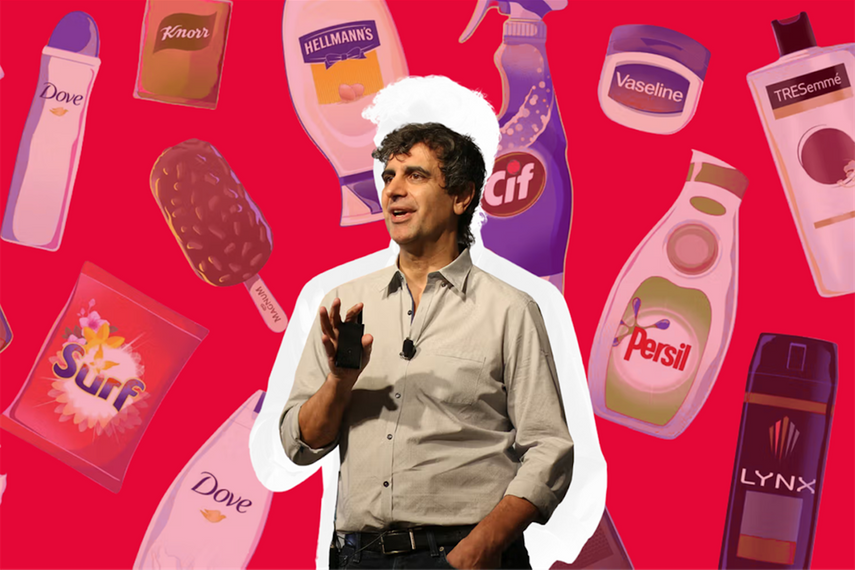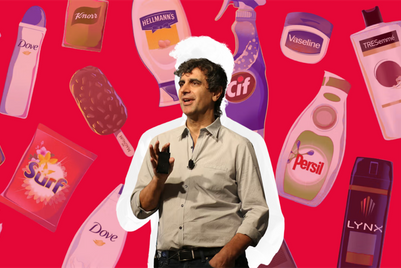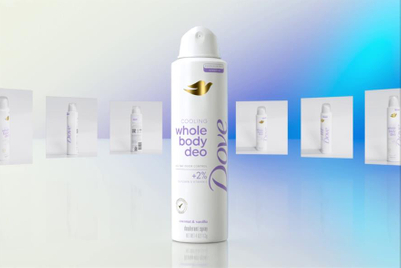
In his first public appearance as chief executive of Unilever, Fernando Fernandez (pictured) last week made the claim that “brands – by definition and by default – are met with scepticism when their messages come directly from corporations”.
To address this, the company boss committed to boosting Unilever’s social media investment from 30 per cent to 50 per cent of total marketing spend.
He explained: “Creating marketing activity systems where others can speak for your brand at scale is incredibly important. Influencers, celebrities, TikTokers – these are the voices that matter.”
As one of the world’s leading FMCG businesses, Unilever’s faith in influencers feels like a significant statement. So, will others follow its lead? And what does this latest development tell us about the hierarchy of the modern marketing mix?
“Influencer is a broad term,” says Ed Brittain, head of social at Pitch. “Transactional commissioned content, influencer ambassador programmes, celebrity partnerships, or affiliate schemes. These all fall under the broad banner of influencer marketing.
“But one thing is true, it needs to be taken seriously and Unilever has clearly set the ambition to do exactly that.”
“It's a big deal,” continues Brittain on Unilever’s latest marketing plans. “The industry loves to talk about change, so this open promise of more influencer, more social will be a popular topic.”
He says if Unilever’s recalibration pays off, it could go so far as to end the debate over whether influencer marketing is prioritised in a marcomms strategy, by firmly cementing its role as essential.
Commercial impact
The evidence of social media's importance within the marcomms mix is already quite compelling, some would argue.
“Influencer marketing has rapidly evolved into a key channel to deepen engagement with communities and help people discover and buy products digitally,” a Dove spokesperson tells PRWeek.
The Unilever-owned skincare brand, known for its prominent influencer work, explains: “Partnering with content creators is not new to our brands; what’s changing is we now have more opportunities to connect to commerce. Social selling is a fast-growing channel and core to our strategy.”
“These channels aren’t just add-ons, they’re now central to corporate growth,” agrees Joe Stratton, influencer client services director at PrettyGreen, who emphasises influencer marketing’s ability to prove tangible results – something PR often struggles with.
“Across FMCG, influencer activity is proving to be a major driver, not just for brand positioning but for commercial impact. The investment Unilever is making shows that when resourced properly, influencer marketing can deliver measurable results at scale.”
The underlying reason for its success is that “social platforms have become more people-centric”, adds Stratton, saying: “We follow people more than we follow brands, we engage with faces more than we engage with products.
“When we talk about influencer marketing at scale, it’s not just about volume—it’s about balancing macro and micro, global and local, ensuring relevancy across different groups.”
Who is an influencer anyway?
In line with this, Dove’s spokesperson confirms: “Our approach to influencer marketing has always been to develop long term relationships with content creators through consistent engagements. This includes nano-influencers (less than 10k followers) with a highly engaged audience, and micro and macro influencers with bigger audience sizes of 10k – 100k or more.”
And as for whether social-native influencers are pushing traditional celebrities out of favour? “It depends on the audience,” answers Stratton.
“Millennials and older generations still view celebrity endorsements as aspirational – pre-social media, talent had an exclusivity factor that created FOMO. Media still amplifies celebrity-driven campaigns, making them effective for generating mass awareness.
“But Gen Z and Gen Alpha operate differently. Their version of celebrity is more democratic – they’ve grown up alongside influencers who feel more like peers than distant figures.”
The PrettyGreen influencer client services director continues: “This is where peer-to-peer credibility plays a huge role. Younger audiences aren’t just looking at who’s famous; they care about cultural relevance and authenticity within their own circles.
“That’s why influencer marketing continues to gain traction – it taps into trust, relatability, and community-driven validation in a way that celebrity endorsements often can’t. As younger demographics gain more spending power, we’ll see this shift accelerate.”
Dove’s definition of ‘influencer’ even spans beyond those active on social media: “It’s important that who we partner with shares the same belief systems as our brands and is relevant in the passion spaces of the people they serve. This extends beyond social media influencers, to subject matter experts such as dermatologists, stylists, gamers and chefs.”
Brittain defines influencer marketing as “using talent to create impact”, giving Unilever’s recent Dirt Is Good partnership with Arsenal as a prime example.
Of Unilever’s renewed focus, he adds: “I'm curiously optimistic that this will continue in a storytelling with impact direction, vs buying #ad real estate on followed feeds.”
“Brands shouldn’t start treating influencers like a simple media buy,” echoes Leanne Bertolone, business director at Tin Man and head of the agency’s ‘Tinfluence’ practice.
“It is much more nuanced than that. Unlike traditional ads, influencer marketing thrives on organic relationships - followers only engage with content that resonates with them and their values.
“Too often, powerhouse brands simply want to pay for impressions through an influencer with a huge following,” she adds.
Cultural representation
Luckily, Unilever seems not to have fallen into this trap. Dove’s spokesperson explains the brand’s more nuanced approach, saying: “We are seeing a significant shift in spend with influencers in markets where we see their impact.
“Our choices will differ based on brand objectives and differences in the media ecosystem across regions and categories.”
Pleased with this element of Unilever’s wider strategy is Ruby-Jade Aryiku, co-founder and PR director at influencer marketing agency Vamp, who says: “What’s particularly impressive about Unilever’s approach is their nuanced understanding of cultural representation.”
She points towards Fernandez’s acknowledgement of “19,000 zip codes in India” and “5,764 municipalities in Brazil”, to which the Unilever boss said: “I want one influencer in each of them. In some of them, I want 100.”
“Many brands have yet to grasp this level of depth,” explains Aryiku, “recognising that influencers, particularly those from diverse backgrounds, are not a monolith.
“It’s crucial for brands to invest in research and develop strategies that resonate with specific audiences rather than applying a one-size-fits-all approach to influencer selection.”
“I’m not surprised to see Unilever taking this stance, but I am impressed by how bold they are in their investment,” she adds.
AI and other challenges
Taking such a hyper-local approach to influencers will require “a machine-like approach to content creation”, according to Unilever boss Fernandez – something he says “AI will play a crucial role” in achieving.
To this, Tin Man’s Bertolone responds: “It’s not surprising to see AI mentioned as a way to power up content creation at scale - but the talk of AI within the creator community seems like an oxymoron to me. The very nature of influencer marketing relies on people.”
Indeed, AI’s role in the influencer world is a hot topic. Beyond tools used to assist with influencer selection, the rise of AI influencers – virtual personalities, built, managed and controlled by specialist coding teams – has caused conversation.
According to a recent study conducted by comms agency Third City, almost half of UK adults (44 per cent) say AI influencers feel “too fake”, while 41 per cent worry they could be misleading, and only five per cent knowingly follow one.
AI influencers may risk damaging consumer trust, but even human influencers have been guilty of this as of late, points out Brittain. As a brand, addressing the challenges of getting a partnership right involves acknowledging that “it will go wrong at some point”, he says.
“Wrong copy, hidden backgrounds, and old tweets” are all risk factors, states the Pitch social lead, raising McDonald’s and Stormzy’s controversy as an example.
“Do the hard yards of audit, don't forget to be human,” he advises in these situations. “Be swift, agile and have a plan in place.”
Though noticing a “diversification of spend across paid, owned and earned channels”, Taylor Herring managing director Sam Corry also warns against “putting all your eggs in the influencer and social basket”.
“No brand owns its audience or community on social media,” he explains. “Social platforms rent you a space, algorithms decide who sees your content, and engagement is highly unpredictable.
“Cast your minds back to the TikTok ban - platforms can disappear overnight, along with your influencer investment, 'community' and 'audience'.”
In light of Unilever’s new strategy, Corry emphasises that “brands can't buy their way to attention”, especially when social algorithms now aim to foster organic discovery over serving content from those you already follow.
“Nearly everything can be swiped or skipped,” he concludes, cementing that earned attention is still the most powerful tool of all – one that traditional PR has firmly in its toolbelt.



.jpg&h=334&w=500&q=100&v=20250320&c=1)


.jpg&h=334&w=500&q=100&v=20250320&c=1)




.jpg&h=334&w=500&q=100&v=20250320&c=1)




.jpg&h=268&w=401&q=100&v=20250320&c=1)
.jpg&h=268&w=401&q=100&v=20250320&c=1)


